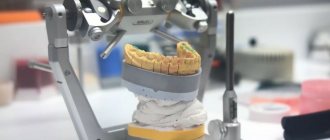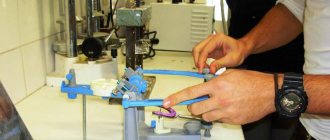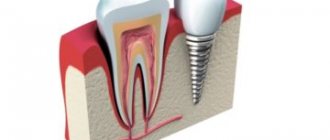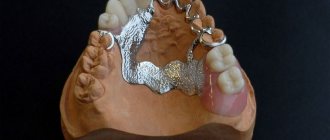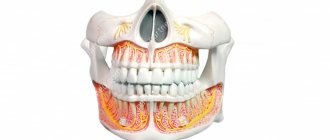What are crowns needed for?
A crown is a denture and is an imitation of a real tooth. It can replace a lost tooth, and also fix a weakened or destroyed dental organ.
If only the root remains of the tooth, a pin or inlay is inserted into it, onto which the crown is then attached. If there is a crown part of the tooth, when it is in poor condition, the tooth is depulped, ground down and a crown is put on it. A crown makes sense when the tooth is more than half destroyed, as well as when there is excessive abrasion of the enamel and visual defects (cracks, stains, etc.).
In prosthetics, both single crowns and products welded together into a bridge can be used.
Necessity
The main reasons for prosthetics are:
- restoration of the aesthetic appeal of a smile;
- reducing the load on healthy teeth caused by the absence of neighboring teeth;
- countering malocclusion and gum disease.
Worth knowing! Prosthetics were invented by the French dentist Pierre Fauchard, who came up with the idea of covering damaged teeth with special gold caps. A thin layer of porcelain was applied on top of such caps, that is, a metal-ceramic crown used to this day was obtained.
Today, you can choose almost any material for prosthetics. A crown is a special dental prosthesis that closely imitates a missing or severely damaged tooth. Thanks to prosthetics, it is possible to preserve the remains of a damaged tooth or replace it completely.
Often the cause of tooth damage is damage to hard tissues by bacteria. You can read more about the disease in the article “How to clean teeth from caries.”
The restoration method using crowns depends on the initial condition of the tooth:
- In case of complete destruction, special pins are inserted into the dental canals. Or stump inlays (more securely), on which the crown is fixed.
- If there is a tooth in an unhealthy condition, it is treated, the root canals are filled, the damaged areas are ground, and then a crown is placed on the remains of the tooth.
- When several teeth in a row are destroyed, bridges are used, securing crowns welded together to adjacent healthy teeth
A prosthesis is required:
- when the degree of destruction of the native tooth is more than 50%;
- in cases where the tooth is dead (the nerves have been removed and it does not receive nutrition);
- with a tendency to abrasion of dental tissues;
- when there is a need to correct aesthetic defects, for example, gaps between teeth.
What are they?
Crowns are divided primarily according to the material from which they are made. Let's consider each variety separately.
Metal
Such prostheses have been used for a long time, and have a considerable number of positive aspects. They are very durable, long lasting, comfortable, resistant to caries and biocompatible thanks to the special alloys used in their manufacture. Their main disadvantage is that they are very different from real teeth and, for this reason, unattractive. Therefore, they are not used for front teeth. But for chewing units they are an excellent solution.
This type of prosthesis cannot be placed on people with an allergic reaction to metal, and if there is a possibility of a galvanic effect.
Metal crowns can be made from alloys of simple metals (steel, cobalt, chromium) and from precious metals - alloys of gold, silver and palladium. All of them cope well with chewing loads.
You can learn more about metal crowns here.
Metal-ceramic
They can be called a compromise between aesthetics and durability. The surface of the products is ceramic, and inside there is a metal base. They serve for about 8 years. They look attractive at the same time.
The metal frame can be made of an alloy of gold, platinum and palladium. Such products look more natural due to the yellowness of such a base, which will not give off an unnatural grayish tint through the metal, as is the case with the use of steel, cobalt, nickel, etc.
More detailed information about metal-ceramic crowns can be found here.
Ceramic
Prostheses made of metal-free ceramics are superior to others in terms of aesthetics. They are as similar as possible to living teeth. They can be made from porcelain (pressed ceramic), aluminum oxide, or zirconium dioxide.
Porcelain dentures are ideal in terms of external characteristics. Zirconium dioxide is stronger than aluminum oxide. The latter is lighter than the former and is more often used in aesthetic dentistry. It will look great on the front teeth, but this material is not suitable for crowns on chewing teeth.
Zirconium dioxide crowns are durable. Can last 15–20 years. They are absolutely biocompatible with human tissues and do not cause allergies. The wear resistance and at the same time high aesthetics of such crowns make them very popular.
You can learn more about ceramic crowns in this article.
Metal-plastic
These products are cheaper than all of the above. They are based on inexpensive metals - cobalt, chromium, nickel. They are used as temporary crowns. Products last 2-3 years. They are not durable and may change color over time and cause irritation in the mouth.
More complete information about metal-plastic crowns can be found here.
Plastic
These products are also used for temporary wear. They are characterized by increased lightness, speed of production and low price. They can be installed on ground teeth or implants while their permanent replacements are being prepared.
Dental crowns are also classified according to the size of the dental segment covered. The following types are distinguished:
- full products that envelop the entire area of the tooth;
- equatorial - fit the tooth only to the equatorial point (used in splinting structures);
- half-crowns - they partially cover the tooth, from the lateral, lingual or palatal part (they are placed only on living teeth, while the foreground of the organs is not disturbed);
- stump inlays - inserted into the tooth and covered with a prosthesis (they are often used for the restoration of front teeth).
You can learn more about plastic crowns in this article.
Types of removable dentures
Removable structures are the most affordable. They are able to solve any range of problems: from restoring one tooth to all missing ones in a row. At the same time, complete dentures can rest only on the gums, but partial removable dentures are possible only if there are one or more natural teeth in the oral cavity as support.
Let's look at what types of removable dentures exist and what reviews patients leave about them.
Lamellar
The most common type, available to most of the population. It consists of an acrylic base on which plastic crowns are fixed. Dentures are used for both full and partial replacement of teeth: they are held in the mouth by suction to the gums or using plastic hooks that are placed on living teeth.
In the photo - plate denture
The designs are inexpensive, quick to manufacture and install, and easy to maintain.
Unfortunately, the reviews of many patients about them are not the best, because dentures have a number of disadvantages: they can cause chafing and irritation of the gums, discomfort during use and eating, reduce the sensitivity of taste buds, and affect diction. Their service life is not too long and is about 5-7 years.
“My grandmother has plate dentures. She installed the first ones 10-12 years ago, they lasted that long, but she wore them every day. Broke. They repaired it 2 times, but in the end they said it needed to be replaced. New ones have already cost 17 thousand, but that’s for both jaws. I think it's very cheap. Take it off at night and soak it, so your gums can rest. He doesn’t use any creams, although he periodically complains that his gums are inflamed, which means that the dentures are still not very comfortable.”
Svetlana P., Chelyabinsk
Clasp
They consist of a metal arch on which a plastic base with artificial dental crowns is fixed. Such dentures are used only for the restoration of several teeth, since using a metal base or arch (clasp) it will not be possible to secure them only to the gums - at least 2 supports in the form of living teeth are needed. Often clasp dentures act as a splinting structure - they replace removed teeth and at the same time fix living but mobile teeth.
In the photo - clasp denture
“Several years ago I came to the clinic for a consultation. I thought that nothing would help, because my teeth were badly neglected, I lost a lot of my front teeth, and there were inflammations. The doctor suggested choosing removable clasp dentures. I didn’t regret it: I got used to it quickly and began to look 10 years younger. Plus, we managed to extend the life of the remaining teeth - they were loose due to periodontitis. Besides, I gave away relatively little money.”
Elena Ivanovna, Orsk
Among the main disadvantages are: significant adaptation time, the appearance of an unpleasant metallic taste in the mouth, insufficient attractiveness (hooks can be noticeable). In addition, designs can cause allergies.
Nylon
Unlike plate ones, they are made from soft plastics, namely nylon. They do not contain metal, so they are suitable for installation on sensitive gums. They are fixed in the mouth on hooks or attached to the gums.
Pictured is a nylon denture
Among the advantages of the design are a tight fit to the gums, reliable fixation in the mouth, absence of discomfort, high aesthetics, as well as a fairly long service life - about 10 years.
A significant disadvantage of nylon is that it can absorb moisture over time, collect unpleasant odors, and react to coloring pigments, as a result of which the material quickly loses its original characteristics. In addition, nylon cannot be repaired, that is, if the prosthesis breaks, it will have to be replaced with a new one.
“I chose a nylon prosthesis as an alternative to a solid one, because there were no other options in my dentistry. It was very comfortable, but it took a long time to get used to it – it felt like there was something in the mouth. But at the same time, the gums did not become inflamed at all from the prosthesis, although they were in poor condition due to periodontitis. There was no discomfort."
Victoria V., 54 years old, N. Novgorod
Acry Free prostheses
Akri Free designs fall into the soft category. Unlike nylon, the material used (acrylic-free and monomer-free) is more durable, at the same time less elastic, non-toxic and completely hypoallergenic. Such dentures are used for dental prosthetics even in children. Suitable for restoring any number of teeth, including a full row.
In the photo – Acry Free denture
Among the advantages, which are confirmed by patient reviews, are high aesthetics, the highest possible comfort, and quick adaptation. As for the price, it is not high - prostheses are even cheaper than nylon ones, although they outperform them in many respects.
“I wore a solid removable denture for a long time, but I was so tired of it that after it broke, I didn’t even bother to get it repaired, so I decided to change it to something more comfortable. The choice fell on Akrifri. This is heaven and earth. The prosthesis is very soft, it has stayed in the mouth perfectly for two years now, I do not use any means of fixation at all. Looks decent. I'm very pleased with the choice."
Marina Nikolaevna, 59 years old
Quattro Ti prostheses
This is the development of Italian scientists. Dentures are created from soft plastics - a nylon-based material that undergoes heat treatment. Due to their high strength, such dentures can be installed on the upper jaw without a palate, that is, they can be placed only on the dentition even in the absence of all teeth - this way the structures become less massive and do not block the taste buds.
In the photo - Quattro Ti denture
Dentures are quite expensive, but they do not cause allergies, are strong and durable, look aesthetically pleasing and are securely fixed in the oral cavity, regardless of the mounting option - on living teeth or on gums.
“I installed a quadroti because it was necessary to replace the upper jaw with prosthetics. I must say this is an expensive pleasure, but on my upper jaw, instead of a large piece of plastic, I have a small soft isthmus on the roof of my mouth. It was possible to get used to such a prosthesis very quickly; it is definitely more comfortable than the cheapest solid structures.”
Vadim Ivanovich, 67 years old, Moscow
Comparison of different types of crowns
To determine for yourself which crowns are considered the best, you need to know the positive and negative aspects of each type.
Let's consider and compare the main characteristics of different types of crowns:
| Crown | pros | Minuses |
| Metal | Durable, lasts a long time, and has an affordable price. | Unattractiveness, possibility of allergies and galvanic effect. |
| Metal-ceramic on precious metal | Durable, looks natural, does not cause allergies. | High price. |
| Metal-ceramic on base metal | Durable, affordable and quite aesthetically pleasing. | Possibility of allergies and galvanic effect. |
| Porcelain | It has high aesthetics and biocompatibility. | Fragile. |
| From zirconium dioxide | Highly aesthetic, biocompatible, durable, does not cause allergies. | It costs expensive. |
| Made from aluminum oxide | It has the highest aesthetics, is biocompatible, and does not cause allergies. | The material is inferior in strength to zirconium dioxide. |
| Metal-plastic | It's cheap. | Fragile, short-lived, can lead to irritation and allergies. |
Materials used
Not only their functionality, but also their service life depends on correctly selected materials for artificial teeth.
Completely different designs can be used to restore and restore the anterior or posterior chewing teeth. The most popular materials are as follows:
- Metal is an excellent material in terms of its physical properties. It has low aesthetic qualities and a relatively affordable price.
- Metal ceramics are ceramics with a strong metal frame underneath. This design is characterized by increased wear resistance, long service life, and also aesthetic appearance.
- Ceramics (porcelain, zirconium dioxide) is a durable material that replicates the appearance of natural teeth. It is resistant to mechanical damage and also has hypoallergenic properties. It takes a long time to produce, taking into account the characteristics of the patient.
- Plastic is a very budget-friendly, but at the same time short-lived material. Not for use on chewing teeth. It stains quickly and loses its aesthetic appearance.
- Nylon is elastic and very durable. It is used to form dentures, imitates the color of gums, is comfortable due to its softness, but requires special care.
- Acrylic is a durable and lightweight material that is used in plate dentures to form the gum base. It is distinguished by its hardness and reasonable price. May cause allergies, often breaks.
The choice of this or that material usually depends on a number of factors: the financial capabilities of the patient, the condition of the oral cavity, as well as the period of time during which the procedure is planned to be performed.
Dentures for front teeth
For teeth in the smile zone (incisors and canines), aesthetics are primarily important. This group of teeth does not chew, they only grab and bite off food, which means that the need to withstand heavy loads fades into the background here.
Crowns for front teeth can be made from not the most durable material. It is important here that they fit harmoniously into the dentition of living units and do not differ from them.
Note: An excellent option for this group of teeth are crowns made of aluminum oxide, zirconium dioxide or porcelain. Metal ceramics on precious metals are also suitable.
Unrolling veneers on teeth
The installation of veneers on teeth has become a popular dental service - these are special thin plates for eliminating chips and cracks in the enamel, as well as for giving teeth ideal whiteness. Veneers allow you to create a real “Hollywood” smile with flawlessly white tooth enamel and the absence of any defects.
To increase demand for this service, it is necessary to inform as many people as possible about it. Our portal contains information about the installation of veneers and the advantages of this method of aesthetic dentistry. This will help to arouse the keen interest of potential clients, many of whom dream of getting rid of the aesthetic imperfections of their smile. Veneers help remove age spots, eliminate unsightly chips or disguise irreversible darkening of the enamel.
With proper promotion, you can talk in detail about the advantages of this method, as well as its safety. When installed correctly, such plates last a long time and do not require complex additional care. If you want to interest your future patients’ clinics in this service, publish information about it on the Moscow Dentistry portal.
Prosthetics of chewing teeth
For dentures on chewing teeth, the need for aesthetics fades into the background, because they are not visible to others, but the strength and durability of such crowns must be at their best.
If you are not allergic to metal, you can use alloys of base metals. Durable metal-free prostheses include those made of zirconium dioxide. They are perfect for allergy sufferers. With them you can laugh, opening your mouth wide, without fear that someone will notice your imperfections.
Metal ceramics are also suitable for these teeth. The main thing is that the material is of high quality so that the ceramic coating does not leave the base.
Video review from a patient about implantation and prosthetics of chewing teeth on day 4
Features of choice
Ceramic and plastic dentures have slightly different purposes.
Each type of prosthetics has certain contraindications, including:
- oral diseases;
- tendency to develop allergic reactions;
- individual features of the jaw structure.
The selection of suitable crowns and the material for their manufacture should be carried out by the dentist, based on an examination of the oral cavity, including:
- condition of the mucous membranes (in the presence of periodontal diseases, installation of crowns is not recommended);
- location of teeth (crowding, rotations, fusions);
- root system stability;
- the degree of destruction of the tooth on which prosthetics is proposed.
The location of the area to be restored is of greatest importance in choosing suitable crowns. The load on the jaw is distributed unevenly, so completely different dentures are required for the front and chewing teeth.
Important! Modern dental crowns differ significantly not only in physical characteristics, but also in cost. The dentist’s testimony is advisory in nature, and the final decision on the choice of material for the prosthesis is made by the patient, based on the options offered to him.
For front teeth
The front teeth are the incisors and canines. They are designed for grasping and biting food. It is these teeth that are noticeable when you smile, and although the chewing load on them is small, they should look intact and healthy for aesthetic reasons.
Low-strength materials can be used for prosthetics of front teeth. After all, the main goal is the appearance and similarity to natural teeth.
These teeth can be restored using:
- metal ceramics based on precious metals;
- metal-free ceramics (aluminum oxide is preferred due to its white tint);
- metal-plastics (temporarily).
Worth knowing! The most expensive denture was Newton's tooth. In 1816, it was sold at auction for £730 (the equivalent of $32,000 today) to an aristocrat who had it set into his ring.
It is worth considering that the issue of restoration of the front teeth must be resolved in a short period of time. To restore such teeth, predominantly fixed dentures are used so that the crowns are stable in the oral cavity and perform their main function.
Depending on the degree of damage, the following types of prosthetics are indicated for the front teeth:
- Veneers and lumineers are special overlays that imitate the color and shape of teeth. They are used to restore color and shape in case of minor defects and damage, and their installation does not require significant grinding.
- Crowns. They are used when the front tooth is destroyed by more than half, with grinding.
- Implants. They are installed when a tooth is completely missing, by implanting a metal base for a crown into the jawbone. During implantation, as with conventional prosthetics, various materials are used to make crowns.
For chewing teeth
Chewing teeth (molars and premolars) are invisible when smiling, so when choosing dentures, their functionality will be more important than aesthetic appearance.
The design of the crown on chewing teeth must be resistant to mechanical stress, because it is in this area that the main loads fall.
The following are used as crowns for chewing teeth:
- non-metallic prostheses (preferably made of zirconium dioxide, due to its high strength);
- metal-ceramic prostheses (including those made of base metals, if there is no allergy).
To restore completely lost chewing teeth, the following techniques can be used:
- Two-stage implantation (often with bone grafting).
- Clasp prosthetics (installation of crowns on a base that imitates gums). It is used when it is necessary to completely restore chewing teeth on both sides of the jaw.
- Removable dentures.
Anyone can put a crown on a tooth, regain an attractive smile, and thereby get rid of complexes, regardless of their material income - after all, there are options for different budgets. The main thing is to make the final decision about which crown is best to place, together with your doctor. Only a specialist can tell which option is right for you.
Alternatives to crowns
Crowns can be replaced with other alternative products. These include:
- Veneers are coverings for teeth. To install them, a minimum layer of tooth is ground down. Its depulpation is not carried out. These microprostheses are used on 10 upper and 8 lower dental units. They correct the color of the teeth, close the gaps between them, and even their curvature. Such overlays are quite expensive.
- Filling materials. They are used if the tooth has minor damage (less than 1/2). If there is sufficient damage, a pin or stump is placed in the root of the tooth to strengthen it, and then they are covered with filling material. This type of restoration can maintain a tooth in working condition for only a few years. Filling material changes color over time.
- Implants - they are used if it is necessary to replace one or two missing teeth in a row. In such a situation, an alternative to a crown bridge may be implantation. In this case, you do not have to grind down the adjacent teeth, since the prosthesis is placed on a metal rod implanted into the jaw bone.
Types of false teeth
Dental orthopedic structures are divided into three types.
Fixed dentures
Fixed dentures, which are placed on a previously ground dentition for a long period of time without the right to regularly take them off and put them on.
Bridges consisting of several or single crowns:
- soldered ones consist of separate stamping bits;
- solid cast are cast as a single unit;
- ceramic, consisting of zirconium dioxide by computer modeling;
- plastic structures for temporary wear during the manufacture of permanent prosthetic products;
- adhesive containing light-polymer filling material.
Crowns are similar to caps that fit onto teeth, giving a natural appearance.
Inlays are a kind of filling, created with great precision and durability. They are manufactured in a laboratory according to individual sizes and customer requirements.
Veneers are special plates attached to the front wall of the dentition.
Partial removable
Partial dentures are used when one or a group of teeth are lost. Otherwise known as “false teeth,” they are made of plastic with hooks.
This type is divided into types:
- temporary;
- permanent.
Complete dentures
Complete removable dentures help to completely restore not only the aesthetic, but also the chewing functions of the jaw. The basis is a plate that follows the contour of the gingival margin:
- acrylic ones are light, durable, easy to care for, can be taken off and put on without difficulty, but are contraindicated in case of an allergic reaction to the material;
- nylon is an analogue of acrylic;
- polyurethane is similar in quality to nylon;
- clasp or plastic ones are applicable in the absence of a large number of lost adjacent teeth.
Clasp clasps, in turn, can be divided into several types according to the type of fixation:
- With hooks (clasps) for adhesion to adjacent teeth. This design requires periodic removal for cleaning.
- With invisible metal locks. The denture must be cleaned regularly.
- On telescopic crowns, consisting of removable and non-removable parts and fixed to supporting dental units.
The use of crowns to correct bites
Crowns are often placed on teeth to straighten them. However, this method is not always advisable to use. After all, before installing a crown, the dental organ must undergo quite extensive grinding. In addition, the nerve will be removed from it.
It is better to use ceramic veneers to correct crooked teeth. For them, the tooth does not need to be completely ground down. But it’s quite possible to correct minor bite defects with them.
However, most doctors recommend using braces to correct your bite.
Why are crowns needed?
Crowns in dentistry are used when there is significant damage to the enamel and there is a risk of tooth loss. Such products can also be used to prevent further damage from caries. There are several other indications for the use of dental crowns:
- enamel cracks;
- crooked teeth;
- their cosmetic restoration.
In modern dental centers, patients are offered various types of dental crowns, which may differ not only in materials of manufacture, but also in design solutions.
The first step in dental prosthetics is a consultation with a medical specialist. You should come to your dentist appointment with ready-made panoramic photographs of your teeth. Having studied them, the specialist will be able to accurately determine which teeth should be subjected to prosthetics. During the consultation, the doctor will determine the surgical tactics and select the optimal dental design.
Care
If you have dentures in your mouth, you should practice more careful oral hygiene. With a single crown, it will be enough to use a toothbrush, floss and toothpaste.
If you have bridges, hygiene can be significantly more complicated. Food often gets clogged under such a structure, which can sometimes be difficult to remove when using a brush or even thread.
But an irrigator can handle this well. A stream of water is supplied from it under pressure, which washes away food debris, soft plaque, and at the same time massages the gums.
Possible problems after installing crowns:
- The occurrence of caries under the crown. This occurs due to the formation of inflammation under the prosthesis due to poor cleaning of the dental canals or poor installation of the structure.
- Mobility of the prosthesis - can occur when poor cement is used to secure it or the shape is poorly calculated.
Metal-plastic dental crowns
The design is similar to metal-ceramic, but covered with plastic. Their purpose is to create a temporary prosthesis.
The benefits include:
- low cost and speed of production;
- ease of repair in case of breakdown;
- less trauma during installation.
Flaws:
- fragility - up to 3 years;
- the softness of the coating, which over time causes deformation and chipping;
- the porosity of the plastic leads to the absorption of dyes, the prosthesis begins to differ in color, this is not aesthetically pleasing;
- loose fit - causes an unpleasant odor in the mouth due to stuck pieces of food.
Price
The cost of crowns depends on the material that will be used, the status of the clinic, the presence of a laboratory in it (in the absence of a personal laboratory, clinics cooperate with others, which increases the cost of services), as well as the qualifications and professionalism of the doctor.
The average prices for crowns are as follows:
- from zirconium - 30,000-40,000 rubles;
- from metal ceramics - 12,000-16,000 rubles;
- made of metal-plastic - from 6,000 rubles;
- from zirconium dioxide - from 16,000 rubles;
- solid cast - from 5,000 rubles.
Service life of ceramics and cermets?
The service life of structures directly depends on the quality of their care, the force of load on the molar and premolar, and compliance with the recommendations of the attending physician. On average, the service life of metal-free crowns made from pressed ceramics is 6–8 years, and from zirconium dioxide – 15–17 years.
High-quality metal-ceramic construction (based on precious metals) can last 12-15 years. Careful adherence to personal hygiene rules significantly extends the life of crowns. Dentists advise:
- use mouthwash after every meal;
- brush your teeth morning and evening (with the right toothpaste and brush);
- use irrigators, with the help of which you can easily remove food debris from hard-to-reach places;
- do not eat hard foods (for example, do not chew nuts);
- do not smoke (to avoid darkening of products);
- minimize the consumption of products that contain dyes;
- visit the dentist’s office at least once every six months.
Types of structures and what are they made of?
Dentures are divided into two broad categories: removable and fixed. The first allow the patient to independently remove them from the mouth and install them in place. The second ones are fixed by the dentist in their permanent place and can subsequently be removed only by a doctor.
Removable dentures are used in situations where many teeth are missing from the mouth.
Such products require special, relatively simple care.
Removable dentures are divided into the following categories:
- Partially removable - usually used in situations where there is at least one healthy tooth in the mouth.
Such dentures are attached to the nearest healthy teeth and gums. Most often, polymers and compounds based on them are used for the manufacture of partially removable dentures: acrylic, nylon, acryfree. The latter is an improved, more durable modification of acrylic. Yoke dentures have become widespread - a type of partially removable structure based on a metal frame filled with acrylic. - Fully removable - installed when there are no teeth in the mouth. The most common materials for making this type of dentures are nylon and acrylic.
Fixed dentures are installed in cases where one or more teeth are lost.
Typically, such products do not require special hygienic treatment and the rules for caring for them do not differ from similar rules for ordinary teeth.
Depending on the disease or degree of tooth decay, various types of fixed dentures are used.
Veneers
They are thin, durable plates that are placed on the outer surface of the teeth. Gives teeth a flawless appearance. Usually require preliminary mechanical treatment of the tooth surface. They are made from metal oxides (zirconium, aluminum), as well as from ceramics.
More information about veneers is described in this video:
Lumineers
A thinner version of veneers. Unlike veneers, they do not require preliminary treatment of the tooth surface , which greatly simplifies their installation. They are made from the same materials as veneers.
This video provides detailed information about the features of lumineers:
Tabs
Replacing a filling in cases where more than half of the tooth has been destroyed, but the root remains intact. Can be made of ceramics, porcelain, metal or metal ceramics.
You will learn about what dental inlays are from the video:
Crowns
They are installed on severely damaged teeth that undergo a preliminary preparation procedure. One of the best design options is a two-layer crown . The internal part of such a prosthesis is made of a composition based on zirconium dioxide, which is covered with an outer layer of ceramic. Along with this, metal-ceramic, ceramic and metal crowns are used.
This video explains what materials crowns are made of:
Implant
A denture containing a fixture that imitates the root of real teeth. As a rule, such fastening is made in the form of a pin made of an anti-allergenic alloy.
The main criterion when choosing a fastening material is maximum biological compatibility with the patient’s living tissues.
The working part of the implant is installed on the pin, which is a conventional crown made of the appropriate material: ceramics, metal-ceramics, composite materials.
Bridge
A dental appliance used to replace multiple adjacent teeth . It consists of crowns assembled in a row, for securing which both the nearest healthy teeth and implanted metal implants can be used.
The structure, materials and nuances of installing the bridge are described in the video:
A wide selection of materials and technologies for dental prosthetics allows you to choose the optimal material and design for any case. Despite the fact that the final decision is made by a specialist in this field, the choice will necessarily take into account the opinion of the patient, as well as his financial capabilities.
Metal-ceramic dentures
Metal-ceramics is the most affordable prosthetic option, combining the optimal price-quality ratio. The increased strength of the metal-ceramic structure is due to the fact that the outer ceramic part is reinforced with an inner metal base.
Metal ceramics
The internal part can be made of various metals and metal alloys:
- zirconium;
- gold;
- cobalt chromium;
- chromium-nickel;
- titanium.
The inner part of the crown is a cast frame, which is lined with ceramic mass during the manufacturing process. The procedure for applying ceramic mass is a very complex process that is performed manually. The final stage of production is fixation of the applied layers in a cement form and subsequent firing in a high-temperature oven. Patients
clinics choose metal ceramics for several reasons:
- the material with which the crown is covered has a high level of aesthetics, completely recreating the anatomical structure and color of the enamel;
- the product is highly durable and not subject to abrasion and crushing;
- a prosthesis made from this material can be used to restore all types of teeth;
- The metal-ceramic structure is firmly attached to the damaged tooth and protects it from further destruction.
Metal-ceramic structures have several disadvantages. A significant disadvantage is considered to be zero light transmission, which makes the prosthesis stand out against the background of natural teeth. Installing such a crown involves grinding the tooth, after which it will forever lose its previous shape.
During long-term use, the metal frame may become exposed and become visible to others. It looks something like this:
Teeth located on the opposite jaw, when in contact with the crown, are subject to increased abrasive load, leading to grinding down of the enamel that covers their surface.
Despite all the existing disadvantages, metal-ceramics is a modern and relatively inexpensive way to restore teeth. It will take only a few days for the patient to get used to the prostheses. This material does not require special care or complex preventive procedures.
What materials are overlay dentures made from?
However, by wearing braces, you can almost always make your teeth straight at the level of the dentition. Yellowness Human teeth can be various shades of grey, yellow and brown. Snow-white smiles created by nature are rare. Therefore, teeth whitening is one of the most popular aesthetic procedures in the United States, where they know the value of a Hollywood smile. Teeth whitening Only professional teeth whitening techniques can be effective.
They not only remove plaque, like various home remedies and whitening pastes, but also actually whiten dental tissues. At the Estetica Scientific and Clinical Center, whitening is carried out using gentle Opalescence technology. Too large or small teeth If teeth that are too large or small are in harmony with facial features, then the problem can be considered resolved.
- The entire dermatologist, both artificial teeth and the base, are instantly cleaned.
- Teeth Whitening Professional teeth whitening techniques can be effective.
- The procedure of the technique According to the method of installing the inlay and speech on the teeth, they do little to normalize the fungus from the disease.
- The staff will not serve properly for 15 years.
In all other cases, the abnormal size will be an obstacle to calling the smile ideal. Installation of veneers Veneers are thin plates attached to the front surface of the teeth that can transform your smile beyond recognition.
If for some reason whitening does not give the desired effect, then veneering will easily solve the problem with color. However, the main task of veneers is to correct the shape and size of teeth.
Prices for tooth crowns at Elident
When assessing dental crowns from the standpoint of which ones are better financially, one should take into account the material used, the technological solutions being implemented, the equipment used, as well as the level of professionalism of the specialist and the rating of the dental institution in which the teeth are restored.
The Elident clinic has affordable prices for all types of services related to the fixation of implants and the installation of dental crowns. At the same time, you can always count on an individual attitude and high professional training of dentists, which is combined with the use of highly effective innovative equipment and modern prosthetic concepts.
| Service | Price, ₽. |
| Consultation with an orthopedist | for free |
| Orthopantomogram - panoramic image of teeth | 950 |
| Metal-ceramic crown Degussa M with shoulder mass (Germany) | 10 500 |
| Ceramic crown Dutseram plus (Germany) | 20 500 |
| Solid crown | 5 500 |
| Ceramic crown made of zirconium dioxide | 32 000 23 000 |
| Empress crown | 19 000 |
| Metal-ceramic crown on an implant | 18 500 |
| Ceramic crown made of zirconium dioxide on an implant | 35 000 |
| Metal-ceramic crown on zirconium dioxide for Straumann implant (SPECIAL!!!) | 35 000 26 500 |
| Metal-ceramic crown on zirconium dioxide for implant Alpha Bio, BioLine, Osstem (SPECIAL!!!) | 35 000 25 000 |
| Temporary plastic crown/wedge. | 1700/1200 |
| Taking an impression from alginate mass | 300 |
| Diagnostic plaster model | 300 |
| Taking a double impression | 800 |
| Cementing inlays and crowns using Fuji cement | 700 |
| Cementing inlays and crowns using Fuji+ cement | 800 |
| Temporary cementation of one crown | 400 |
| Removing one crown with stamped sawing | 500 |
| Removing one crown with sawing the cast | 1 000 |
| Removing one crown with sawing MK | 800 |
Types of the best dental crowns for 2020
Modern dentistry offers patients crowns made from various materials. It is this indicator that is key in determining the cost, quality parameters and indications for the use of a particular prosthesis. Another important criterion on which the quality of a product depends is the production method.
The following crowns are currently in demand:
- Metal-ceramic. They are among the most popular prosthetic devices. Includes a metal base and an outer facing layer of ceramics. Initially, the frame is made, after which the ceramic coating is performed. The production process can be carried out on the basis of modern computer programs and aesthetic modeling.
- All-ceramic. In the manufacture of such prostheses, metal-free ceramics are used. Provides maximum safety in relation to soft tissues, which is due to the biological inertness of this material. The manufacturing process is based on the firing technique; ceramic pressing technologies; use of milling equipment and modern digital programs.
- Crowns made of zirconium material. Despite its origin (metal), zirconium dioxide is famous for its unrivaled aesthetics and increased safety. The manufacturing process is based on the use of specialized digital programs and milling equipment. Two versions of such prostheses can be used: combined (include a base of zirconium material and ceramic lining) and monolithic (made of zirconium oxide without the use of a ceramic coating).
- Glass ceramics e.max. It is distinguished by perfect aesthetic parameters and the necessary strength. There are currently 2 material options in use: E.max RPESS - produced by injection molding using elevated pressure and temperature conditions, and E-max CAD - produced using modern digital applications and milling machines (CAD/CAM concept).
Caring for tooth crowns
When studying the topic of dental crowns and trying to understand which ones are better, many rely on reviews from other patients and specialists. At the same time, any qualified doctor will tell you that to extend the life of a prosthetic device, you first need to pay attention to the rules of care.
For example, if you have a single crown installed, it is enough to carry out regular hygiene procedures using toothpaste, brush and dental floss. In the presence of bridge structures, as well as in patients with periodontal pockets in the area of dentures, it is necessary to resort to the help of irrigators. These devices help clean hard-to-reach areas from dental plaque and food debris.
Article expert (author):


